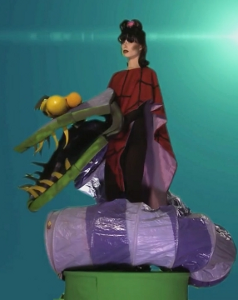When I first heard about Yugioh in the 90s, I thought it was a ridiculous concept. It seemed like the worst kind of commercialism. It pandered to children. It was an anime and manga series designed to promote a real life card game and toy series. I can be very cynical and I immediately dismissed the entire franchise on face value.
Then I saw some people playing the card game at my school and it caught my interest. I headed over to the local toy store, picked up the Pegasus and Yugi starter decks for my brother and me, and forced him to play the game. It was pretty darn clever. The game played a lot faster than Magic the Gathering and featured a huge variety of characters from the start. Each new set expanded the possible playable characters rather than just strengthening what was already available. It was, and still is, a pretty novel approach to building a trading card game.
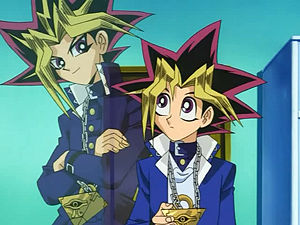
Yami and Yugi team up through the power of the Millenium Puzzle
From there, I backtracked to reruns of the anime series (the 2000 version is the one that was released in the US; the 1998 version did not get broadcast here) on Saturday morning. I kind of fell hard for the show.
Yugioh, in the initial manga and anime run (counting the 1998 version, as well), played heavily on Egyptian mythology. The main character, Yugi Moto, becomes possessed by the spirit of a pharaoh after solving the Millenium Puzzle, an artifact from his reign in Egypt. The pharaoh, Yami Yugi, takes over Yugi Moto’s body whenever he plays any of the modern adaptations of the ancient shadow games.
This actually puts the games in their original dangerous context. Unsurprisingly, 4Kidz–the US anime distributor that lost all of their licenses after butchering One Piece–sanitized the show beyond recognition. If you lose a match in the shadow realm, you die. Period. Your soul is trapped in the shadow realm with only a slight chance that you can be resurrected. 4Kidz said you were asleep and removed all of the menacing violence from the show.
Beyond the violence, Yugioh had a surprising amount of depth in its original run. The Egyptian mythology is only one level. There’s an interesting play on psychology with the relationship between Yugi Moto and Yami Yugi. It’s not a coincidence that they share a name; Yugi Moto has to use Yami Yugi to become a self-actualized person and a championship game player. The lessons he learns from Yami allow him to function in the world. There’s also commentary on international relations, gender politics, science v. religion, and a whole slew of other subjects. You just wouldn’t recognize it in the 4Kidz release.
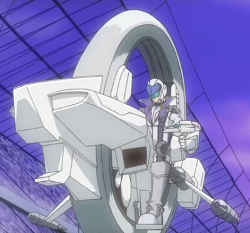
High tech duels on fast bikes in Yugioh 5D’s
The series has rebooted itself three times already. The first,
GX, reset an almost identical story in a dueling school. Some of the most powerful TCG cards got their start in this run but the substance was lacking.
5D’s went heavy on the sci-fi with high tech motorbike racing and a lot of Western genre tropes stacked together in interesting combinations.
Zexal reinvented the series with another intriguing concept, focusing on the lives of the characters in the cards before they became part of the game.
Somehow, Yugioh has managed to stay in the public eye for 17 years in Japan (about 14 in the US) and it’s more popular now than it’s ever been. Even if the anime and manga aren’t selling as briskly, the TCG has grown bigger than you can imagine. The game is popular enough to have multiple leagues–Dragon Duels for children under 12, Hobby League for casual play, Yugioh Championship Series for the competitive players–and many play styles. New sets are released four times a year with various specialty sets in between. The eligible pool of cards is adjusted every few months to re-balance the game among all the available cards.
Even with the high cost of remaining competitive, Yugioh keeps growing. It’s not unheard of to spend hundreds of dollars on a deck to be competitive at the large YCS tournaments. The TCG sets are released a few months after the Japanese OCG sets, allowing US players to plot their new strategies and drive up demand (and prices) before the cards are even available here.
Around 2008 or so, Konami (the current card game developers) began revisiting old archetypes from the original run of Yugioh. They turned under-used characters like Ninjas and Six Samurais into YCS-winning mainstays with just a few cards. They’re constantly looking back on the history of the game to play on nostalgia and change the meta–the much argued about rankings of decks and viable cards in the competitive scene. A new set introduced a few cards that could make Harpies, one of the oldest game archetypes, into a championship deck for the first time.
Well, tournament-winning deck for someone not named Robert Gannon. When I do play, I play my own spin on Harpies and my deck has been largely unchanged since 2003. I’m flexible enough to adjust the strategy on the fly to deal with deck the archetype is weak against and practiced enough to honestly say I lose more by my own mistakes than to an opponent’s strategy.
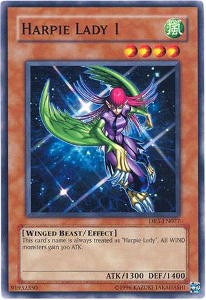
Harpie Ladies spawn and power up really fast once you lock the field
The most compelling part of
Yugioh for me is the diversity. There is so much variety in the game that everyone can find a strategy that suits them. I’m a control freak who likes to lock down the field and power up in any TCG I play. Harpies have let me do that for about a decade. Other people like to go for one turn kills or massive combos that end the game quickly. Still others really go out there, aiming for victory conditions like deck outs (where your opponent no longer has any cards to draw) or winning on a tie breaker (if a match is not finished in 40 minutes, everything is decided in 3 turns). You can be inspired by type, combos, archetype, special summoning, spells, traps, or the minutia of the rules. How you play is up to you and every style of play can win with the right player.
This is where the staying power comes in. Konami keeps the game fresh with new cards and basically a new legal playset every few months. Players adjust to the meta, swapping in key cards or finding new territory to explore. Sometimes you succeed and sometimes you fail. You don’t know unless you play and you don’t play this game unless you’re really interested in it. Children compete against adults on a pretty level playing field. The rules are simple but the combinations and strategies are very open-ended and rely a lot on the luck of the draw.
14 years ago, I would have never imagined calling myself a fan of Yugioh, let alone a Yugioh player. I am. I don’t get to compete as much a I’d like to because of the cost of entry, but I find a way. This post was initially going to cover the YCS event in the Meadowlands, NJ two weeks ago. It’s literally down the street from me. I wound up getting caught up with work and pulling out. I wish I could have made it since my deck runs very well against the deck style that dominated the Top 32 final rounds.
One thing I know for sure is that, for the foreseeable future, there will always be another tournament to go to. Even if it’s at my local card shop or in the backroom of a convention, I’ll be able to pull out my deck and roll to see who goes first. A lot of TCGs have come and gone since Yugioh made its international debut (I miss you, Kingdom Hearts). Yugioh just happens to be the one that stuck well enough to break the world record for most TCG cards sold.
Thoughts on Yugioh? Share them below.
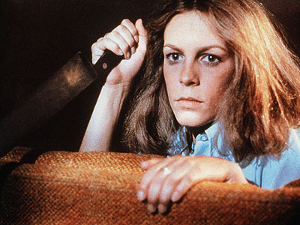 Don’t you just love it when well-loved genre actors have new shows created for them? Two fan favorites are coming back to TV in new genre shows that should showcase what they do best with a new spin.
Don’t you just love it when well-loved genre actors have new shows created for them? Two fan favorites are coming back to TV in new genre shows that should showcase what they do best with a new spin.

 This week on Face Off, the 12 remaining makeup artists finally competed in their first solo Spotlight Challenge. They had to create original underground monster/prisoners inspired by random things in randomly assigned underground rooms. I already explained my problems with the design of the challenge in the new
This week on Face Off, the 12 remaining makeup artists finally competed in their first solo Spotlight Challenge. They had to create original underground monster/prisoners inspired by random things in randomly assigned underground rooms. I already explained my problems with the design of the challenge in the new 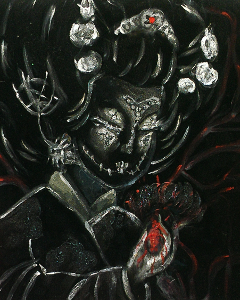
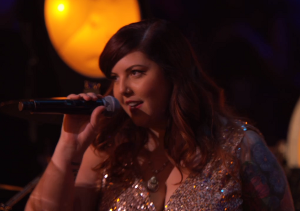 If you’ve heard the wonderful song “Same Love” by Macklemore & Ryan Lewis, you already know who Mary Lambert is. She wrote the chorus of that song in under two hours and recorded it. She’s a singer/songwriter and poet from Seattle
If you’ve heard the wonderful song “Same Love” by Macklemore & Ryan Lewis, you already know who Mary Lambert is. She wrote the chorus of that song in under two hours and recorded it. She’s a singer/songwriter and poet from Seattle